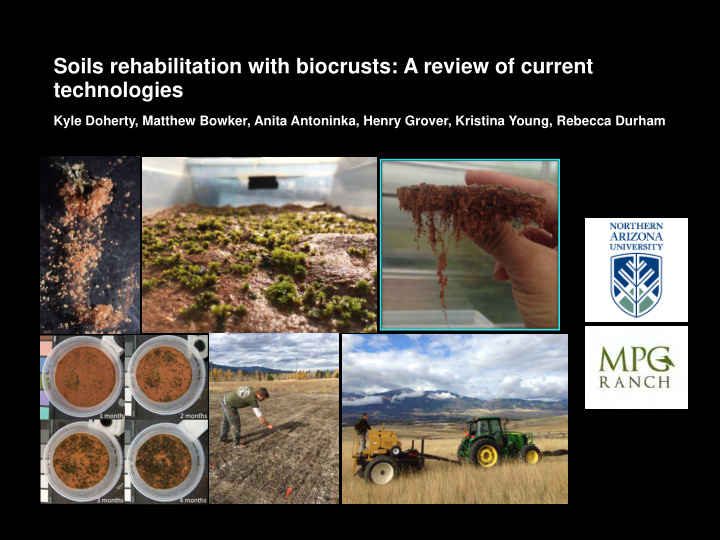



Soils rehabilitation with biocrusts: A review of current technologies Kyle Doherty, Matthew Bowker, Anita Antoninka, Henry Grover, Kristina Young, Rebecca Durham
Roadmap • Intro: What are biocrusts? • Advances in propagation • Hardening and establishment • Importance of timing treatments • Ongoing projects and future directions
Biocrust!
Soil Stabilization
Carbon Nitrogen
…but I heard they grow slowly?
Forest and Rangeland Soil Ecology Lab Group School of Forestry
Forest and Rangeland Soil Ecology Lab Group School of Forestry
Propagation
Doherty et al. 2015
THE BRYOTRON B
Experiments with Syntrichia ruralis Days per 5 Populations week hydrated X
ANOVA result Effect DF F-value p -value Population 4 7.9242 <0.0001 (5 month exp.) Hydration 3 29.5009 <0.0001 Interaction 12 2.2048 0.0244
Physiologically stressful watering Rapid drying <1hr Pulse of mist Green cultivated moss Measured how many spritzes until yellowing? Experiment performed by our technician Jeff Wright
Yes, differential acclimation/adaptation to watering stress Effect DF F-value p-value Population 4 8.5496 4.946E-06 *** Prior Watering 3 1.4229 0.2401 Interaction 12 1.1358 0.3394 Prior watering from first experiment had no effect!
Fire Moss 2 years post-fire
Bryum argenteum Funaria hygrometrica Ceratodon purpureus
Potential applications: Burned Area Emergency Response (BAER)
Sandy or Ash, Organic charcoal, Soils or both Two Species X X
Early on we established: 1. We can rapidly cul8vate diverse and func8onal biocrusts from most star8ng material 2. Op8mal culture condi8ons vary depending upon the organism and system Antoninka et al. 2015
Hardening and Field Establishment
Maximizing field hardiness As with nursery plants, biocrust might need some help adap7ng from the luxurious greenhouse condi7ons to the harsh field condi7ons
How well does our inoculum survive in the field? 4 watering treatments (2,3,4,5 days con=nuous hydra=on; from Antoninka et al. 2015) Hardening for 21 days: 1. Luxury (GH condi=ons, 24 hours water) 2. Full UV and 2-3 hours hydra=on 3. ½ UV 2-3 hours hydra=on
Best results with outdoor hardening and short dura1on watering during cul1va1on period *Total cover-inoculum addi1on-cover in control plots
Results so far: 1. Jute and Straw improved biocrust establishment *Total cover-inoculum addi4on-cover in control plots
Results so far: 1. Jute and Straw improved biocrust establishment 2. Straw be2er for stability *Treatment slake-control slake
Timing
Bandelier National Monument
History of Bandelier National Monument, NM Photo by Craig Allen Photo by NPS October 2002
May 2015 Install May 2016 2 nd plots and collect post-treatment pre-treatment data July 2015 October 2015 1 st data collec<on Added post treatment data inoculum collec<on
Results We saw no biocrust growth 11 months a3er we applied inoculum We saw no increase in soil stability related to our treatments of flashing, slashing, and seeding We saw large seasonal changes in soil quality and stability unrelated to our treatments. This is a very dynamic system
Future Directions
Delivery mechanisms
Exploring effects on vascular plants
Modeling biocrust abundance and richness ● ● ● ● ● ● ● ● ● ● ● ● ● ● ● ● ● ● 46.72 ● ● ● ● ● ● ● ● ● ● ● ● ● ● ● ● ● ● ● ● Predicted Richness ● ● ● ● ● ● ● ● ● ● ● ● 30 ● ● ● ● ● ● ● ● 20 ● ● ● ● ● ● ● ● ● ● ● ● ● ● ● ● ● ● 10 ● ● ● ● ● ● ● ● 46.70 ● ● ● ● ● ● y ● ● ● ● ● ● ● ● Actual Richness ● ● ● ● ● ● ● ● ● ● ● ● ● ● ● ● ● ● ● ● ● ● ● ● ● ● 30 ● ● ● ● ● ● ● ● ● ● ● ● 20 ● ● ● ● ● ● ● ● ● ● 10 ● ● ● ● ● ● ● ● ● ● ● ● ● ● ● ● ● ● 46.68 ● ● ● ● ● ● ● ● ● ● ● ● ● ● ● ● ● ● ● ● ● ● ● ● ● ● ● ● ● ● ● ● − 114.025 − 114.000 − 113.975 x
Fogponics
Takeaways • Yes we can grow biocrust components rapidly • We are approaching biocrusts from a plant materials mentality, mosses are plants too! • Biocrusts are essential to ecosystem function in western US, please include them in management and funding strategies
Acknowledgements NAU Phillip Patterson Nancy Johnson Pete Chukran Jeff Wright Troy Wood BLM UNLV Wayne Padgett Lloyd Stark Adrienne Pilmanis ASU Ferran Garcia-Pichel Ana Giraldo Sergio Velasco-Ayuso
Recommend
More recommend